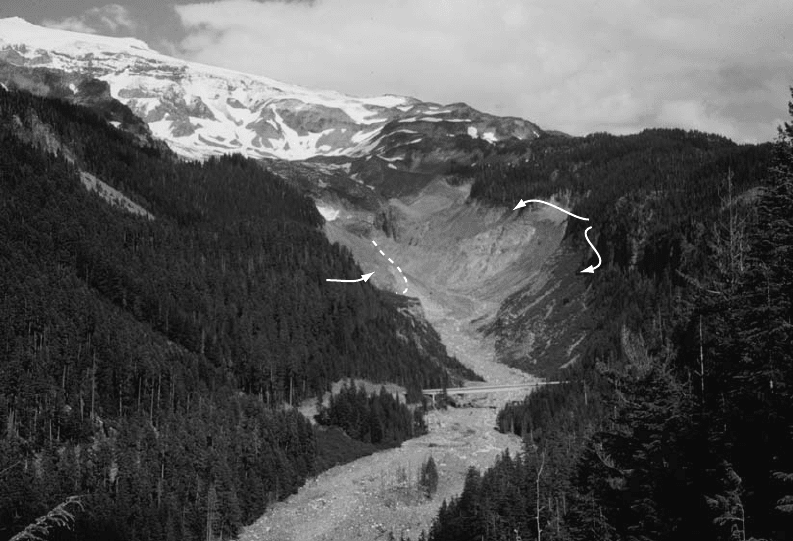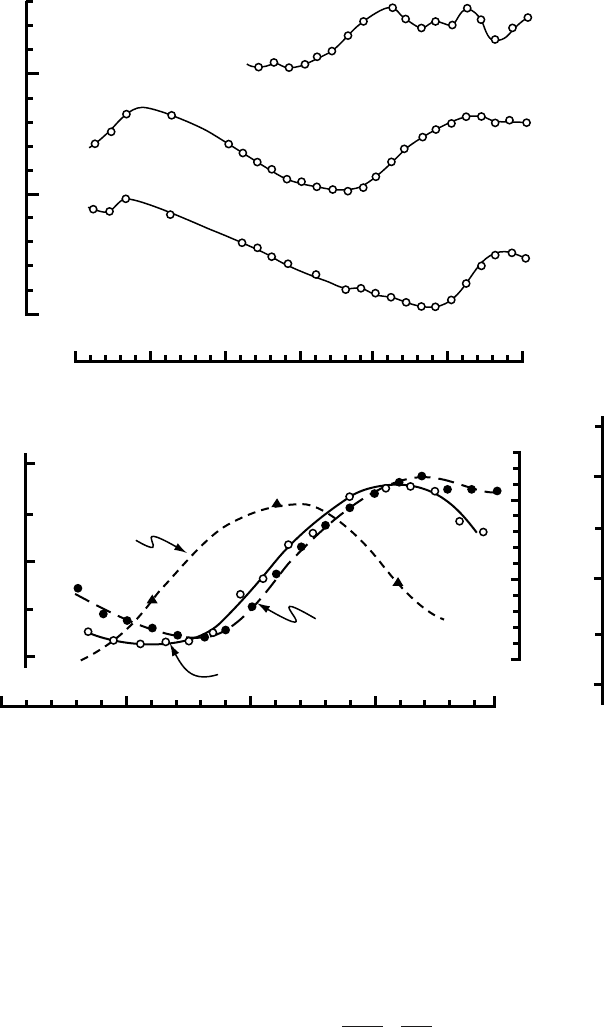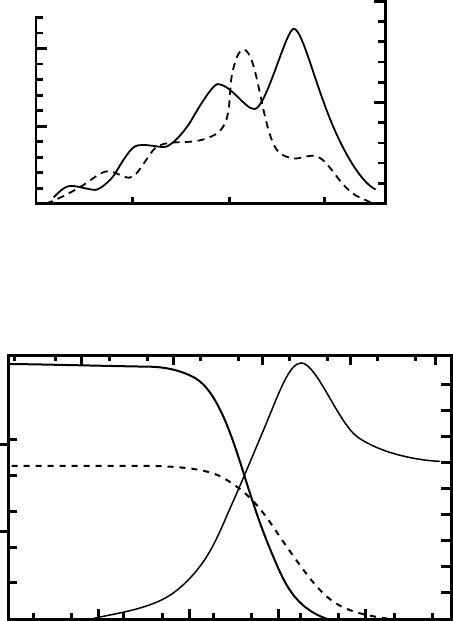Hooke R.L. Principles of glacier mechanics
Подождите немного. Документ загружается.

Numerical modeling of glacier responses 381
low slopes may be expected to have longer response times, a character-
istic that does not appear in J´ohannesson et al.’s formulation.
For purposes of illustration, let us put some realistic numbers into
some of these equations. The ablation rate on the lower part of the
tongue of Storglaci¨aren averages ∼1.3 m a
−1
and the mean thickness
over the central region of the glacier is between 100 and 150 m, so t
V
is
∼100 years. Rigorous estimates of G
e
and b
e
probably could be obtained
for Storglaci¨aren, but as the necessary calculations have not been done
let us use the approximations that Elsberg et al. found appropriate for
South Cascade Glacier. Then, b
e
≈−0.98 m a
−1
and G
e
≈ 0.003 a
−1
(Schytt, 1968, and unpublished data), so t
VH
ranges from ∼150 to ∼300
years, depending on the value of H.For comparison, numerical model-
ing (Brugger, 1992) suggests a response time of ∼80 years, while field
measurements show that about 2/3ofStorglaci¨aren’s retreat from its
Little Ice Age maximum position, which it reached in 1910, took place
in ∼45 years (Holmlund, 1987). The sizeable difference between t
V
and
t
VH
probably reflects, in part, the fact that the denominator in Equation
(14.31)isasmall difference between two numbers that are large (com-
pared with their difference) and that have large uncertainties. However,
the result serves to emphasize the potential importance of the B¨o
ðvarsson
effect. The more rapid response observed is likely to be a consequence
of two factors: (1) b(
0
)was probably higher (more negative) when the
glacier extended to lower elevations, and (2) the change from Little
Ice Age conditions was hardly a small perturbation. In any case, all of
these times are substantially longer than the 1/5r
0
(≈13 years) time scale
mentioned above. This is in part because diffusion is neglected in the
latter, as noted, and in part because the 1/5r
0
time scale does not allow
enough time to accumulate or lose the required mass, and thus violates
conservation of mass.
Numerical modeling of glacier responses
In the absence of analytical solutions to Equation (14.13), glaciologists
have resorted to numerical modeling. In such models one can, in addition,
retain nonlinear effects which are neglected in linearized theories. Thus,
the models are not restricted to infinitesimal perturbations. Furthermore,
one can use glacier shapes and mass balance patterns that are specific to
a particular glacier.
A good example is a model of Hintereisferner in the Austrian Alps
by vandeWal and Oerlemans (1995). First the authors calculated a
surface profile that would be in equilibrium with a certain mass bal-
ance rate, b
0
(x)(Figure 14.10a). Then they increased the mass balance
rate by 0.5 m a
−1
for one year. This could represent the situation

382 Response of glaciers to changes in mass balance
Figure 14.10. (a) Longitudinal profile of Hintereisferner in a stable state.
(b) Changes in thickness of Hintereisferner resulting from a 0.5 m perturbation
in mass balance, b
1
,attime t = 0. The increase in b
n
lasted 1 year. Times are in
years. Thickness changes are larger than 0.5 m because they include a
contribution from the unperturbed mass balance, b
0
.T= terminus. (c) Change
in thickness at the terminus of Hintereisferner as a function of time after the
perturbation. (Both (a) and (b) are reproduced from van de Wal and Oerlemans,
1995, Figures 7a and 9b, with permission of the authors and the International
Glaciological Society; (c) is calculated from data in Figures 9b and 9c of van de
Wal and Oerlemans, 1995.)

Comparison with observation 383
during an unusually positive balance year (see the curve labeled “+”in
Figure 3.5a or that labeled “Cold year” in Figure 14.6). The following
year, the net budget was returned to its normal value. Figure 14.10b
shows the increase in thickness as a function of distance from the head
of the glacier at various times after the perturbation. After 2 years, a wave
has formed with its crest ∼3kmfrom the head, or about 1 km upglacier
from the equilibrium line. By the sixth year, the crest is a little more
than 4 km from the head, representing a wave speed of about 300 m a
−1
.
For comparison, the depth-averaged velocity over this part of the glacier
is a little under 50 m a
−1
.Inaddition, the wave has been dampened
and lengthened by diffusion. With time, diffusion continues to smooth
the wave, the surface in the accumulation area sinks back towards its
original level, and the surface in the ablation area, particularly at the
terminus, rises sharply. In Figure 14.10c it will be seen that the terminus
begins to collapse back to its original form after about 30 years, but that
a significant thickening remains after 100 years.
The Hintereisferner modeling experiment serves to emphasize that
kinematic waves on glaciers are likely to be long and low, as mentioned
earlier. Thus, sophisticated survey techniques are required to detect them
in the field. In addition, the modeling suggests that the wave speed is ≥ 6
times the depth-averaged velocity,
u, rather than ≤5u as implied by
Equation (14.6) and the following discussion. Van de Wal and Oerlemans
think that this may be due to changes in the longitudinal strain rate which
appear in the numerical model but which are not taken into consideration
in the linear model. Such changes are likely to affect the q–h relation.
Finally, the response at the terminus is stable, as shown in Figure 14.10c.
Comparison with observation
Let us now discuss some actual examples of how glaciers have
responded to climatic perturbations. We have already mentioned Stor-
glaci¨aren briefly, and noted that estimates of the response time based on
Equation (14.30), on a numerical model, and on observation are rea-
sonably consistent with each other, and suggest a time of decades to a
century. As expected, t
VH
is longer than t
V
,but the magnitude of the
difference between them is probably due, in part, to errors in estimating
the parameters. In contrast, 1/γ
0
is only ∼13 years. Nisqually and South
Cascade glaciers are two others that have been studied extensively.
Nisqually Glacier
Nisqually Glacier on Mt Rainier in Washington retreated several hun-
dred meters during the first part of the twentieth century. A trimline

384 Response of glaciers to changes in mass balance
Debris-covered
glacier tongue
Trimlines
Figure 14.11. Nisqually Glacier, Mt Rainier, Washington, in September, 1964,
showing distinct trimline. The glacier tongue is covered with debris.
on the valley side above and down glacier from the present terminus
(Figure 14.11) shows the shape of the glacier at its nineteenth-century
maximum position, a position that it occupied, more or less, from about
1840 to 1910 (Meier, 1965,p.803). Thus, the difference in elevation
between the present (debris-covered) glacier surface and the trimline
represents the amount of thickening that would need to occur in order
for the glacier to readvance to that maximum position. The amount of
thickening increases rapidly toward and down-valley from the terminus.
The response of Nisqually Glacier to perturbations in mass balance
is illustrated in Figures 14.12 and 14.13. The upper part of Figure 14.12
shows that the net budget was generally positive between 1942 and 1951.
In fact, the retreat rate of many temperate alpine glaciers in the Northern
Hemisphere decreased during this time period, and some actually
advanced. Thus, this represents a major climatic event (Meier, 1965,
p. 803). However, in the middle part of Figure 14.12 it will be seen that
the terminus was still retreating during this time; it was responding to
negative mass budgets of the early 20th century. The total retreat between
1918 and 1960 was ∼1000 m.

Comparison with observation 385
1920 1930 1940 1950
−1500
−1000
−500
0
+500
−5
0
+5
Approximate
net budget
1940 1950 1960
meters, water-equivalent
Distance below 1961 terminus
Recession of semi-stagnant terminus
O
n
s
e
t
o
f
p
r
o
n
o
u
n
c
e
d
t
h
i
c
k
e
n
i
n
g
Figure 14.12. Recession of Nisqually Glacier between 1918 and 1961, together
with the advance of a wave of pronounced thickening and the approximate
net budget. (Reproduced from Meier, 1965, Figure 8, with permission of the
author.)
In the mid 1940s, a wave of thickening was detected ∼1500 m
upglacier from the terminus, and this wave was tracked downglacier
until it reached the terminus in about 1960 (lower part of Figure 14.12).
This wave was presumably a response to the positive mass budgets of
the 1940s. The progress of the wave is documented in Figure 14.13a,
which is based on surveys, conducted almost every year, of the elevation
of the glacier surface along three profiles across the glacier. The aver-
age elevation of the ice surface on each profile is shown as a function
of time. At Profile 3, which is 2.7 km from the mid-twentieth-century
terminus, thickening began in about 1945. Profile 2 is 1.6 km from the
terminus; thickening began there in 1949. The wave reached Profile 1,
0.8 km from the terminus, in 1955. In Figure 14.13b the ice surface
slope, surface elevation, and velocity are shown as functions of time at
Profile 2. As noted earlier, this is probably not a pure kinematic wave
as the changes in thickness and velocity are rather large. Thus, some

386 Response of glaciers to changes in mass balance
1930 1940 1950 1960
1940 1950 1960
1840
1820
1800
0
50
100
Ice velocity, m a
−1
Ice surface elevation, m
0.30
0.20
0.10
Tangent of surface slope
Profile 2
Profile 3
Profile 2
Profile 1
Ice surface elevation, m (arbitrary datum)
100
50
0
Slope
Velocity
Surface
elevation
(a)
(b)
Figure 14.13. (a) Variation in ice surface elevation on three transverse profiles
on Nisqually Glacier, 1931–1960. (b) Variations in ice surface elevation, velocity,
and surface slope at Profile 2, 1943–1960. ((a) is from Johnson, 1960, Figure 2;
(b) is from Meier, 1965, Figure 4; reproduced with permission of the authors.)
other mechanisms, such as an increase in sliding speed, were probably
involved.
The reader may find it of interest to compare the change in velocity
in Figure 14.13b with that predicted by Equation (5.7) with u
b
= 0:
u
s
=
2
n + 1
ρgα
B
n
h
n+1
(14.32)

Comparison with observation 387
To do this, take the differential of Equation (14.32) and divide the result
by Equation (14.32)toyield:
du
s
u
s
= n
dα
α
+ (n + 1)
dh
h
(14.33)
To make this calculation you need the ice thickness, which is about
80 m at Profile 2. Despite the approximations inherent in Equations
(14.32) and (14.33) and in estimating the values of the parameters in
Equation (14.33) from the field data, the calculated du
s
is surprisingly
close to that observed. (The numerical computations are left as an exer-
cise for the reader; see Problem 14.2.)
South Cascade Glacier
Owing to the availability of an impressive data base, South Cascade
Glacier is another that has been analyzed in some detail. We have already
mentioned Harrison et al.’s use of these data. In addition, Nye (1963b)
used them to test the kinematic wave theory. To do this, he had to take
into consideration the three-dimensional character of the glacier. Thus
our Equations (14.8) and (14.10) become:
∂ Q
1
∂x
+ w
0
∂h
1
∂t
= w
0
b
1
(14.34)
Q
1
= c
0
h
1
+ D
0
α
1
where Q(x)isthe ice flux through a cross section of the glacier at position
x, and w
0
(x)isthe width of the glacier as a function of x.Inaddition, c
0
and D
0
have to be redefined as:
c
0
=
1
w
0
∂ Q
∂h
0
and D
0
=
1
w
0
∂ Q
∂α
0
As was the case with Equations (14.8) and (14.10), Equations (14.34)
are a pair of simultaneous differential equations that can be solved for
the changes in ice flux, Q
1
(x, t), and thickness, h
1
(x, t), resulting from a
perturbation in mass balance, b
1
(x, t).
Previously (Equations (14.6) and (14.17)) we found that, in the
absence of sliding, c
0
and D
0
could be related to certain measures of the
speed and ice flux. Thus, if the geometry and velocity field of a glacier
are known, reasonable estimates of c
0
(x) and D
0
(x) can be made. Nye cal-
culated these parameters for South Cascade Glacier (Figure 14.14) and
used the results to solve Equations (14.34) for the situation in which per-
turbations in b
1
varied sinusoidally with period, T,inyears, or frequency,
ω = 2
/T. The solution is expressed in terms of series approximations,
and detailed study of it is beyond the scope of this book. Numerical
results are shown in Figure 14.15.

388 Response of glaciers to changes in mass balance
0123
0
5
10
x10
7
w
0
D
0
,
m
3
a
−1
5
0
10
x10
4
Distance from head of glacier, km
D
0
c
0
w
0
c
0
,
m
2
a
−1
Figure 14.14. w
0
c
0
and
w
0
D
0
as functions of x for
South Cascade Glacier. (After
Nye, 1963b,p.104, Figure 7.
Reproduced with permission
of the author and the Royal
Society, London.)
45
o
90
o
135
o
0
j
10110
−1
10
−2
10
−3
10
−4
10
20
30
50
40
0
100
200
300
10,000 1,000 100 10 1
w,
a
−1
j/
w,
a
|
H
|
/b
1
,
a
Period, a
j/w
|
H
|
/b
1
j
Figure 14.15. Theoretical response of the terminus of South Cascade Glacier
to a sinusoidal perturbation of amplitude b
1
, period, T, and frequency, ω. Curves
shown are the phase lag, ϕ, the time lag ϕ/ω, and the amplitude of the response
|H|/b
1
. (After Nye, 1963b,p.107, Figure 9. Reproduced with permission of the
author and the Royal Society, London.)
The curve of ϕ in Figure 14.15 is the phase lag between the vari-
ation in budget and the response of the terminus. For example, for an
oscillation in mass balance that has a period of 100 years, the phase lag
is approximately 110
◦
. This means that the maximum thickness of the
glacier at the terminus (and hence the maximum extent of the glacier)
would occur (110/360) · 100
∼
=
31 years after the maximum in the mass
balance. This latter number can be read from the curve of ϕ/ω, using
the inner scale on the left side of the figure. Thus ϕ/ω is the time lag
between the maximum accumulation rate and the maximum thickness.
Forvariations in budget with very long periods, the phase lag decreases,

Comparison with observation 389
but the time lag does not change appreciably. For example, for an oscil-
lation with a period of 1000 years, the time lag is ∼43 years. Conversely,
for oscillations with a period of only 1 year, which would represent the
seasonal cycle from winter accumulation to summer melt, ϕ = 90
◦
so
the time lag is
1
/
4
year. In other words, the maximum thickness does not
occur when the rate of snow fall is a maximum, but rather at the end of
the accumulation season when accumulation gives way to melt.
The curve of |H|/b
1
shows the change in thickness of the glacier
at the terminus, expressed in terms of the perturbation in accumulation.
Foraperturbation with a period of 100 years, the increase in thickness
here would be about 100 times the amplitude of the perturbation. Thus,
a perturbation with an amplitude of 0.1 m would produce a change in
thickness of ∼10 m.
The ultimate objective of an analysis such as this might well be
to solve the inverse problem, namely, given a history of advance and
retreat of a glacier, to deduce the mass balance history and thus to learn
something about the climatic changes that produced the fluctuations.
Nye (1965b) did this for South Cascade Glacier and for Storglaci¨aren
with mixed results. He concluded that the records of terminus position of
the two glaciers were not sufficiently well known to accurately deduce
annual changes in net budget, but that coarser features of the records
yield net balance figures that are in agreement with decadal means of
recent observations.
It is of interest to use the data in Figure 14.14 to estimate the respec-
tive time scales from Equations (14.19). As South Cascade Glacier
averages about 800 m in width, t
C
∼
=
47 years and t
D
∼
=
33 years.
T. J ´ohannesson (written communications dated November 7 and 14,
1996) suggests that time scales calculated in this way, however, are likely
to be maximum estimates because many perturbations do not cover the
entire glacier and thus are advected and diffused over the glacier more
rapidly. Nevertheless, the relative magnitudes should be correct. Because
t
D
< t
C
, disturbances should be damped by diffusion before a significant
unstable response is generated. T. J´ohannesson (written communication
dated December 23, 1995) finds that this is generally the case, and thus
argues that diffusion cannot be neglected.
As with Storglaci¨aren, it is difficult to estimate t
V
for South Cascade
Glacier because, again, there is a riegel beneath the middle of the ablation
area. However, it appears that 100 <
h
0
max
< 200 m and b(
0
)
∼
=
5ma
−1
,
so 20 < t
V
< 40 years. Using detailed field data to evaluate b
e
, G
e
, and H,
Harrison et al. (2001) obtained a value of t
VH
of ∼36 years. These values
are reasonably consistent with those for t
C
and t
D
obtained above, partic-
ularly considering that the latter are likely to be maximum values. This
is somewhat unusual, however, as J´ohannesson et al. (1989) find that t
V
390 Response of glaciers to changes in mass balance
is usually significantly longer than t
C
or t
D
,asnoted earlier. The value of
t
VH
is also consistent with Nye’s estimate of 43 years. For comparison,
the 1/r
0
time scale for South Cascade Glacier is about 15 years.
Summary
In this chapter, we have reviewed Nye’s kinematic wave theory for pre-
dicting the response of a glacier to changes in mass balance, and have
solved the resulting linearized equation (Equation (14.13)) for a simpli-
fied situation neglecting diffusion. Largely because it neglects diffusion,
this solution predicts response times that are, in general, too short. The
more complete approaches that Nye (1963a, b) used in his later papers,
however, are sensitive to conditions at the terminus of the glacier, so
although the linearized theory can yield reasonable estimates of the
response time if these terminus conditions are well known, attempts
to generalize from it have often led to times that are too long. Never-
theless, evidence from real glaciers is consistent with at least two of the
conclusions from Nye’s theory: that the most visible response is at the
terminus, and that this response lags the perturbation by years, decades,
or even centuries.
J´ohannesson et al.(1989)have suggested three alternative time
scales for adjustment. Their time scales for propagation and diffusion
of a disturbance over a glacier, t
C
and t
D
, provide measures of the time
required for the glacier to adjust its shape (but not size) to changed con-
ditions. Their volume time scale, t
V
,onthe other hand, utilizes a con-
servation of mass argument. That is, after a change in climate a glacier
will be either too large or too small, and thus will not be in equilib-
rium with the changed conditions. It takes time for the surplus or deficit
in mass balance to bring about the necessary change in volume. Thus,
the volume time scale is more consistent with “response times” based
on observation, and indeed with those based on numerical modeling.
Harrison et al. (2001)have refined J´ohannesson et al.’s approach to
include the B¨o
ðvarsson effect, an effect that lengthens the predicted
response time, especially on relatively flat glaciers, and that can lead to
an unstable response.
Numerical modeling suggests that kinematic waves such as those
which Nye envisioned should form on glaciers, but they are likely to be
long and low, and the increase in speed within them, small. Thus, they
will be difficult to detect. Additional factors, such as major changes in
conditions at the bed, are probably responsible for the impressive waves
that have been documented by field observations. Because diffusive pro-
cesses dampen kinematic waves relatively rapidly, unstable responses
(Figure 12.1b)inareas of compressive flow are unlikely.
